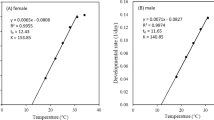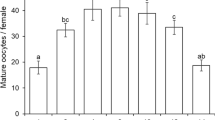Abstract
The objective of our study was to assess thepotential of the egg parasitoid Anagrusatomus L. (Hymenoptera: Mymaridae) for controlof the greenhouse leafhopper Empoascadecipiens Paoli (Homoptera: Cicadellidae). Theegg-adult development time, survivorship andreproduction of A. atomus were evaluatedat four constant temperatures (16, 20, 24 and28°C). Developmental time ranged from33.6 days at 16°C to 13.3 days at 28°C. Based on a linear regression ofdevelopment rate on temperature the lowerthreshold was estimated at 8.39°C. Anagrus atomus required 263.2 degree-days tocomplete its development from egg to adult. Theegg-adult survival rate and the sex ratio weresignificantly lower at 28°C than at theother three temperatures tested. The intrinsicrate of increase (r m) variedsignificantly between all four temperatures.The potential of A. atomus to attackdifferent host ages was additionallyinvestigated. Host eggs were parasitizedthroughout their development but rate ofparasitism was reduced in host eggs older thansix days. The number of eggs parasitized waspositively density dependent but the rate ofparasitism decreased with increasing hostdensity. A maximum rate of parasitism of 62.5%was recorded. The potential impact of the eggparasitoid on the population dynamics of E. decipiens is discussed.
Similar content being viewed by others
References
Anonymous, 1998a. Pflanzenschutzmitteilungen Obst-, Reb-und Gemüsebau der Eidgenössischen Forschungsanstalt für Obst-, Wein-und Gartenbau 17/1998. FAW, Wädenswil, Switzerland.
Anonymous, 1998b. Pflanzenschutzmitteilungen Obst-, Reb-und Gemüsebau der Eidgenössischen Forschungsanstalt für Obst-, Wein-und Gartenbau 18/1998. FAW, Wädenswil, Switzerland.
Campbell, A., B.D. Frazer, N. Gilbert, A.P. Gutierrez and M. Mackauer, 1974. Temperature requirements of some aphids and their parasites. J. Appl. Ecol. 11: 431–438.
Cerutti, F., J. Baumgärtner and V. Delucchi, 1991. The dynamics of grape leafhopper Empoasca vitis Göthe populations in southern Switzerland and the implications for habitat management. Biocontrol Sci. Techn. 1: 177–194.
Chantarasa-ard, S., Y. Hirashima and T. Miura, 1984. Ecological studies on Anagrus incarnatus Haliday (Hymenoptera: Mymaridae), an egg parasitoid of the rice planthoppers. Esakia 22: 145–158.
Cooper, S., 1993. The biology and application of Anagrus atomus (L.) Haliday. Bulletin OILBSROP 18(8): 42–43.
Cronin, J.T. and D.R. Strong, 1990a. Biology of Anagrus delicatus (Hymenoptera: Mymaridae), an egg parasitoid of Prokelisia marginata (Homoptera: Delphacidae). Ann. Entomol. Soc. Am. 83: 846–854.
Cronin, T.T. and D.R. Strong, 1990b. Density-independent parasitism among host patches by Anagrus delicatus (Hymenoptera: Mymaridae): experimental manipulation of hosts. J. Anim. Ecol. 59: 1019–1026.
Cronin, J.T. and D.R. Strong, 1993. Substantially submaximal oviposition rates by a mymarid egg parasitoid in the laboratory and field. Ecology 74: 1813–1825.
Cronin, J.T. and D.R. Strong, 1994. Parasitoid interactions and their contribution to the stabilization of Auchenorrhynca populations. In: R.F. Denne and T.C. Perfect (eds), Planthoppers: Their Ecology and Management. Chapman and Hall, New York. pp. 799.
Dixon, A.F.G., 1987. Parthenogenetic reproduction and the rate of increase in aphids. In: A.K. Minks and P. Harrewijn (eds), Aphids, Their Biology, Natural Enemies and Control. Elsevier, Amsterdam. pp. 269–285.
Institut für Gemüse und Obstbau und Arbeitkreis Betriebswirtschaft in Gartenbau, 1999. Datensammlung für die Betriebsplanung im Intensivgemüsebau, Vol. 7. Institut für Gemüse-und Obstbau und Arbeitkreis Betriebswirtschaft in Gartenbau (eds), Hannover University, Germany. pp. 61.
Habib, A., A. Badawi and F. Herakly, 1972. Biology study on certain species of leafhoppers, (Hemiptera: Cicadellidae) in Egypt. Zeitschrift für angewandte Entomologie 71: 171–178.
Hassell, M.P., 1985. Insect natural enemies as regulating factors. J. Anim. Ecol. 54: 323–334.
Helyer, N.L. and A. Talbaghi, 1994. Evaluation of Buprofezin against Green Leafhopper (Empoasca decipiens). Tests Agrochem. Cultivars 15: 8–9.
Hokyo, N., K. Kiritani, F. Nakasaji and M. Shiga, 1966. Comparative biology of the two scelionid parasites of Nezara viridula (L.) (Hemiptera: Pentatomidae). Appl. Entomol. Zool. 1: 94–102.
Hulting, F.L., D.B. Orr and J.J. Obrycki, 1990. A computer program for calculating and statistical comparison of intrinsic rates of increase and associated life table parameters. Entomologist 73: 601–612.
Jacobson, R.J., R.J. Chambers and J.C. van Lenteren, 1996. Control of glasshouse leafhopper (Hauptidia maroccana: Homoptera, Cicadellidae) within an IPM programme in protected tomatoes. Bulletin OILB-SROP 19: 67–70.
Lessells, C.M., 1985. Parasitoid foraging: Should parasitism be density-dependent? J. Anim. Ecol. 54: 27–41.
Liljesthröm,G.G. and E. Virla, 2001. Spatial density dependent egg parasitism of Delphacodes kuscheli (Homoptera: Delphacidae) by Anagrus flaveolus (Hymenoptera: Mymaridae) in Tuncumán province, Argentina. Egg parasitoid News 13: 10.
Loginova, E., 1992. Some new pests of glasshouse crops in Bulgaria and their control by an IPM programme. Bulletin OEPP/EPPO Bulletin 22: 357–361.
Maisonneuve, J.C., J. Blum and L.R.Wardlaw, 1995. Contre la cicadelle de la tomate en serre. Un nouvel auxiliaire: Anagrus atomus. Phytoma 471: 24–27.
Meyer, J.S., C.G. Ingersoll, L.L. McDonald and M.S. Boyce, 1986. Estimating uncertainty in population growth rate: Jacknife vs. bootstrap techniques. Ecology 67: 1156–1166.
Meyerdirk, D.E. and M.S. Moratorio, 1987. Seasonal population density of Anagrus giraulti (Hymenoptera: Mymaridae), an egg parasitoid of Circulifer tenellus and Empoasca spp. (Homoptera: Cicadellidae). J. Econ. Entomol. 80: 362–365.
Murphy, B.C., J.A. Rosenheim, R.V. Dowell and J. Granett, 1998. Habitat diversification tactic for improving biological control: Parasitism of the western grape leafhopper. Entomol. Exp. Appl. 87: 225–235.
Ossiannilsson, F., 1981. The Auchenorrhyncha (Homoptera) of Fennoscandia and Denmark. Fauna Entomologica Scandinavia 7(2).
Raatikainen, M., 1967. Bionomics, enemies and population dynamics of Javesella pellucida (F.) Homoptera: Delphacidae. Ann. Agric. Fenn. 6: 1–147.
Raupach, K., C. Borgemeister, M. Hommes, H.-M. Poehling and M. Sétamou, 2002. Effect of temperature and host plants on the bionomics of Empoasca decipiens Paoli (Homoptera, Auchenorrhyncha: Cicadellidae). Crop Protec. 21: 113–120.
Rupp, J., 1999. Zikadenbekämpfung an Gurken auf der Insel Reichenau 1998. Gemüse 3/99: 172–173.
SAS Institute, 1992. SAS User's Guide: Statistics, version 6th edition. SAS Institute, Cary, NC.
Schmidt, U. and J. Rupp, 1997. Zikadenschäden an Gurke auf der Insel Reichenau. Gemüse 12/97: 691–692.
Sokal, R.R. and J.F. Rohlf, 1995. Biometry. The Principles and Practice of Statistics in Biological Research, 3rd ed. Freeman, New York.
Tounou, A-K, H.-M Poehling, K. Agboka, K. Raupach, J. Langewald, G. Zimmermann and C. Borgemeister, 2003. Evaluation of entomopathogenic fungi Metarhizium anisopliae and Paecilomyces fumosoroseus (Deuteromycotina: Hyphomycetes) for control of the green leafhopper Empoasca decipiens (Homoptera: Cicadellidae and potential side effects on the egg parastoid Anagrus atomus (Hymenoptera: Mymaridae). Biocontr. Sci. Technol. 13: 715–728.
Triapitsyn, S.V. and M.S. Moratorio, 1998. Host associations of Anagrus nigriventris Girault (Hymenoptera: Mymaridae) and techniques for its rearing under insectary conditions. Mitteilungen der BBA 356: 185–191.
Van Driesche, R.G., 1983. Meaning of “percent parasitism” in studies of insect parasitoids. Environ. Entomol. 12: 1611–1622.
Williams, D.W., 1984. Ecology of the blackberry-leafhopper-parasite system and its relevance to California grape agroecosystems. Hilgardia 52: 1–33.
Author information
Authors and Affiliations
Corresponding author
Rights and permissions
About this article
Cite this article
Agboka, K., Tounou, A.K., Al-moaalem, R. et al. Life-table study of Anagrus atomus, an egg parasitoid of the green leafhopper Empoasca decipiens, at four different temperatures. BioControl 49, 261–275 (2004). https://doi.org/10.1023/B:BICO.0000025385.52826.87
Issue Date:
DOI: https://doi.org/10.1023/B:BICO.0000025385.52826.87




